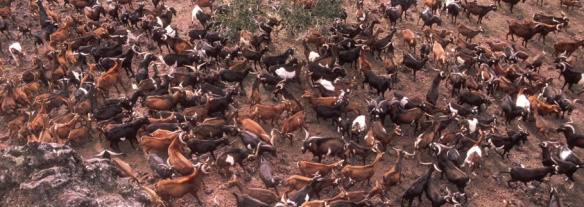I’ve never really liked goats. Something about their smell, the dead eyes and annoying bleat. So growing up on a smallholding in Cornwall in the 1980s with a handful of the creatures was something of a trial: my mother named one Mischief – not without good reason. It seemed that no matter how hard you hammered the spike to tether them into the ground they would find a way to escape. And then they would head towards the garden, greenhouse or vegetable plot and begin to feed. However, unlike other animals that might eat a few plants and then proceed to curl up and siesta the goat will stroll around picking the growing tips of as many choice plants as it can find and ringing as many newly planted trees and shrubs. It is this almost hellish characteristic that I most disliked and which has led to them being nick-named ‘The Desert Makers’. My favourite saying in reference to goats as a species was ‘the best kind of goat is a curried one’.
Thus the introduction of goats as an ‘alien’ species to the Galápagos Islands by whalers and fur seal trappers from the 18th-century onwards was a huge environmental disaster for the ecology of that most unique archipelago. Roll forward to the close of the 20th-century and the Galápagos National Park’s decision to implement an eradication programme on several of the islands. At 4,588 – square kilometres Isabela is the largest and one of the youngest of the islands being a mere 500,000-years old. After over 200-years without an apex predator to trouble it the goat population had soared to over 100,000. But how to eliminate so many animals who blend in very well to the background over such a large and inhospitable terrain? Now the goat is a highly gregarious and social animal and in that single fact lay the solution. Dominant male goats were assembled. They were sterilised, fitted with radio collars and had their horns painted with a highly visible paint. These ‘Judas Goats’ were then air-dropped at strategic points all over the island. Once they had gathered a large enough herd around them a helicopter would seek them out and teams of professional marksmen would shoot all but the Judas males. After the extermination the male would be captured and relocated to another location to begin his ‘job’ all over again.
Thus, after nearly 9-years and nearly US $10-million in costs the goat population on Isabela has been reduced to zero. The flora is rejuvenating rapidly and the island’s ecology is significantly healthier. A shame though that so much potentially good goat curry had to be left on the island for the Hawks and Iguanas.

Postscript: the introduction of non-native species, seeds and plants to the Galápagos National Park is severely forbidden and rigorous screenings take place at every point of entry. However the largest threat to the disruption of the island’s ecology today remains, as always, human activity. Whilst tourists are very conscious of the risks involved in bringing in ‘undesirable aliens’ it seems that people who arrive from the mainland to work in the burgeoning tourist industry are not. Plants, seeds and small animals such as rabbits have recently been confiscated at the main airport.

Love goats!
curried or otherwise ,Cinnamon was my favourite !!! XX
LikeLike
There is an interesting experiment using goats in the Gully on the Downs in Bristol to encourage wildflower rich grassland. http://www.avongorge.org.uk/wildlifeconservation.php?ContentID=21
LikeLike
Let’s hope they don’t go feral and reduce it to a desert. Wild Boar have done great work in the Forest of Dean too. Hot as Hades here today, how anything ever managed to evolve under these conditions I do not know! Dx
LikeLike